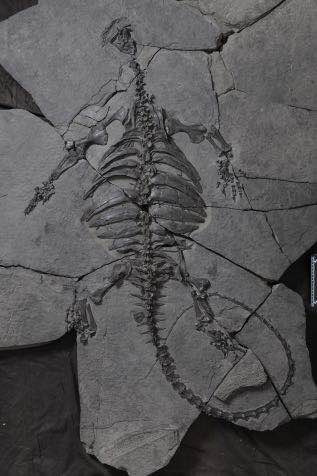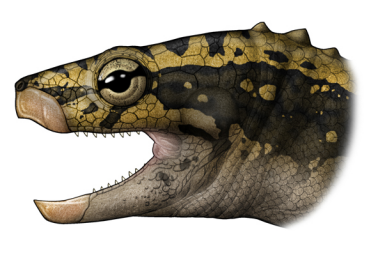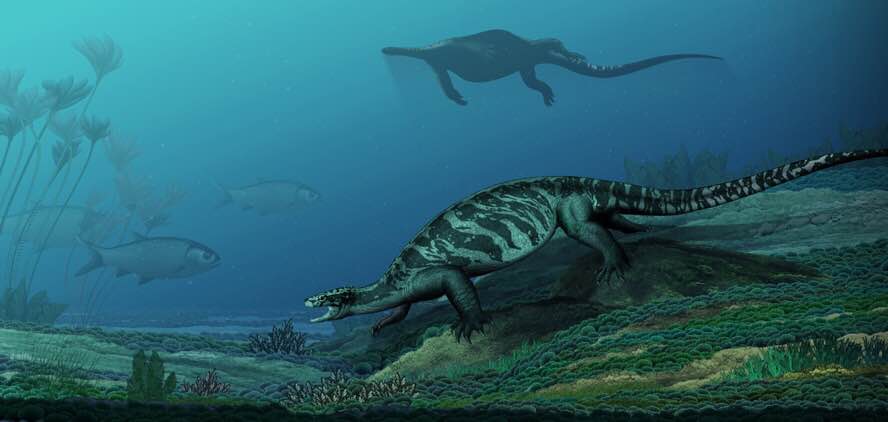

A team of international researchers has discovered the fossil of a 228-million-year-old turtle in Southwest China’s Guizhou Province.
The research findings, published on Wednesday in the journal Nature, said that the turtle had no shell but had a beak.
Researchers named the turtle Eorhynchochelys sinensis or "dawn beak turtle from China."
The fossil was more than two meters long and had a Frisbee-shaped body with wide ribs, a slender tail and a short trunk. The turtle's "important weapon" had not yet formed.

The fossil of the newly discovered Eorhynchochelys sinensis. (Photo: Institute of Vertebrate Paleontology and Paleoanthropology)
“It had a beak, and its carapace and plastron were not formed," said Li Chun, a researcher at the Institute of Vertebrate Paleontology and Paleoanthropology.
Other early turtles had a partial shell but no beak. Odontochelys semitestacea, dating back 220 million years and discovered by Li Chun’s team in Guanling in 2008, had teeth, a protective shell on its underside but no a carapace.

Artist's impression of how the turtle looked. (Photo: Institute of Vertebrate Paleontology and Paleoanthropology)
Pappochelys, which lived 240 million years ago and were found in Germany in 2015, had a bony structure over its belly.
“Eorhynchochelys sinensis lived between the more primitive Pappochelys and the Odontochelys semitestacea. The findings further shed light on the evolution of turtles,” Li said.
As to why the Odontochelys semitestacea, which appeared later than Eorhynchochelys sinensis, possessed teeth but had no beak, Li said, "We can't provide a clear explanation. It shows the complexity of the evolution of early turtles.”

Artist's impression of Eorhynchochelys sinensis's life(Phpto: Institute of Vertebrate Paleontology and Paleoanthropology)
Guanling is known as the “fossil treasure house” for findings on Odontochelys semitestacea and Eorhynchochelys sinensis.
“Southwestern Guizhou Province and northeastern Yunnan Province should have the best fossil preserves of the Triassic period’s marine reptiles,” Li said. (Source: The Paper)

 Award-winning photos show poverty reduction achievements in NE China's Jilin province
Award-winning photos show poverty reduction achievements in NE China's Jilin province People dance to greet advent of New Year in Ameiqituo Town, Guizhou
People dance to greet advent of New Year in Ameiqituo Town, Guizhou Fire brigade in Shanghai holds group wedding
Fire brigade in Shanghai holds group wedding Tourists enjoy ice sculptures in Datan Town, north China
Tourists enjoy ice sculptures in Datan Town, north China Sunset scenery of Dayan Pagoda in Xi'an
Sunset scenery of Dayan Pagoda in Xi'an Tourists have fun at scenic spot in Nanlong Town, NW China
Tourists have fun at scenic spot in Nanlong Town, NW China Harbin attracts tourists by making best use of ice in winter
Harbin attracts tourists by making best use of ice in winter In pics: FIS Alpine Ski Women's World Cup Slalom
In pics: FIS Alpine Ski Women's World Cup Slalom Black-necked cranes rest at reservoir in Lhunzhub County, Lhasa
Black-necked cranes rest at reservoir in Lhunzhub County, Lhasa China's FAST telescope will be available to foreign scientists in April
China's FAST telescope will be available to foreign scientists in April